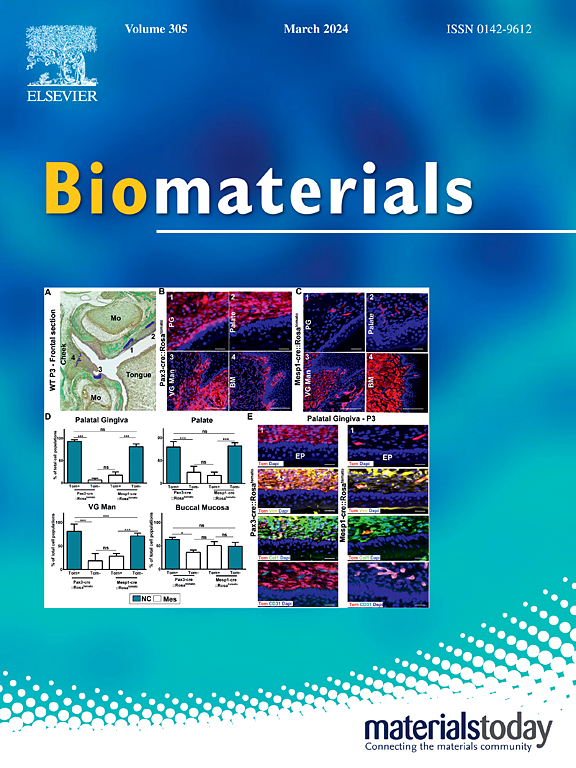表面功能化细菌:下一代活生物疗法的前沿探索。
IF 12.9
1区 医学
Q1 ENGINEERING, BIOMEDICAL
引用次数: 0
摘要
筛选健壮的活菌来生产活生物治疗产品(lbp)是生物医学应用的一个新兴研究领域。尽管它们具有在生物界面上定植和增殖的天然能力,但利用细菌进行此类应用受到功能不满意和安全问题的相当大挑战的阻碍。利用细菌表面的高度定制和适应性显示出改善治疗效果和实现lbp定制功能的巨大潜力。本文综述了近年来细菌表面功能化的实验室策略,旨在解决这些挑战,增强生物医学的治疗效果。首先,我们介绍了用于细菌表面功能化的各种功能材料,包括有机、无机和生物材料。其次,将实现细菌表面功能化的方法分为共价键合、非共价相互作用和杂交技术三种主要方法,并从多个角度比较了不同修饰策略的优点和局限性。随后,综述了表面功能化细菌在生物成像和疾病治疗中的应用现状,特别是在炎症性肠病(IBD)和癌症的治疗中。最后,提出了表面功能化细菌作为lbp的发展面临的挑战和迫切问题。本文章由计算机程序翻译,如有差异,请以英文原文为准。

Surface-functionalized bacteria: Frontier explorations in next-generation live biotherapeutics
Screening robust living bacteria to produce living biotherapeutic products (LBPs) represents a burgeoning research field in biomedical applications. Despite their natural abilities to colonize bio-interfaces and proliferate, harnessing bacteria for such applications is hindered by considerable challenges in unsatisfied functionalities and safety concerns. Leveraging the high degree of customization and adaptability on the surface of bacteria demonstrates significant potential to improve therapeutic outcomes and achieve tailored functionalities of LBPs. This review focuses on the recent laboratory strategies of bacterial surface functionalization, which aims to address these challenges and potentiate the therapeutic effects in biomedicine. Firstly, we introduce various functional materials that are used for bacterial surface functionalization involving organic, inorganic, and biological materials. Secondly, the methodologies for achieving bacterial surface functionalization are categorized into three primary approaches including covalent bonding, non-covalent interactions, and hybrid techniques, while various advantages and limitations of different modification strategies are compared from multiple perspectives. Subsequently, the current status of the applications of surface-functionalized bacteria in bioimaging and disease treatments, especially in the treatment of inflammatory bowel disease (IBD) and cancer is summarized. Finally, challenges and pressing issues in the development of surface-functionalized bacteria as LBPs are presented.
求助全文
通过发布文献求助,成功后即可免费获取论文全文。
去求助
来源期刊

Biomaterials
工程技术-材料科学:生物材料
CiteScore
26.00
自引率
2.90%
发文量
565
审稿时长
46 days
期刊介绍:
Biomaterials is an international journal covering the science and clinical application of biomaterials. A biomaterial is now defined as a substance that has been engineered to take a form which, alone or as part of a complex system, is used to direct, by control of interactions with components of living systems, the course of any therapeutic or diagnostic procedure. It is the aim of the journal to provide a peer-reviewed forum for the publication of original papers and authoritative review and opinion papers dealing with the most important issues facing the use of biomaterials in clinical practice. The scope of the journal covers the wide range of physical, biological and chemical sciences that underpin the design of biomaterials and the clinical disciplines in which they are used. These sciences include polymer synthesis and characterization, drug and gene vector design, the biology of the host response, immunology and toxicology and self assembly at the nanoscale. Clinical applications include the therapies of medical technology and regenerative medicine in all clinical disciplines, and diagnostic systems that reply on innovative contrast and sensing agents. The journal is relevant to areas such as cancer diagnosis and therapy, implantable devices, drug delivery systems, gene vectors, bionanotechnology and tissue engineering.
 求助内容:
求助内容: 应助结果提醒方式:
应助结果提醒方式:


